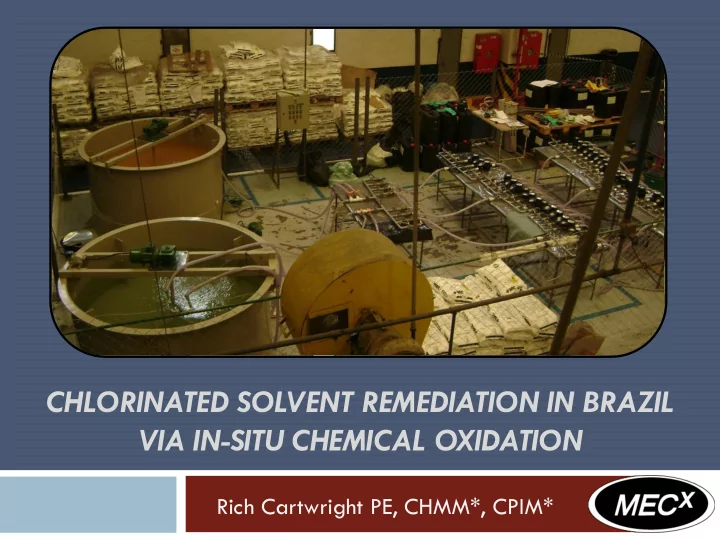

CHLORINATED SOLVENT REMEDIATION IN BRAZIL VIA IN-SITU CHEMICAL OXIDATION Rich Cartwright PE, CHMM*, CPIM*
Co-Authors Isaac Aboulafia PE Doug Carvel PE Larry Rader PG
Facility Overview Active manufacturing of pots/pans Historical release of tetrachloroethylene (PCE) PCE affected nearby drinking water wells Two affected zones SCALE (m): 0 20 40 4-9 m: sandy clay 10 9-12 m: clay Pre-ISCO pump & treat for 6 years
ISCO Technical Challenges Pressure & temperature control Vertical contaminant migration Chemical storage and safety Operational interruptions
International Challenges (Brazil or otherwise…) Safety culture Lack of ISCO experience Chemical handling Language, hand signals, etc. Units of measure Logistics for equipment & chemicals
ISCO Process Oxidant and reagent screening Continuous dosage refinement Oxidant demand empirical modeling (initial dosage determination) D esign P arameter E valuation (dosage refinement) 1. Pilot field application (dosage refinement) 2. Full-scale field application 3.
Oxidant Screening/Selection Volts (1) Oxidant Fluorine (F) 3.0 Hydroxyl Radical (OH• ) 2.7 Sulfate Radical (SO4• ) 2.6 Ozone (O 3 ) 2.4 Sulfate (S 2 O 8 -2 ) 2.1 Hydrogen Peroxide (H 2 O 2 ) 1.8 Permanganate (MnO 4 - ) 1.7 Chlorine (Cl 2 ) 1.4 (1) = Provided by FMC Corporation
Activating Sodium Persulfate Activation methods for sodium persulfate: Presence of transition metal Heat (> 40 o C) Hydrogen peroxide (H 2 O 2 ) Alkaline conditions (high pH) Catalyzed hydrogen peroxide (CHP) uses synergistic activation via 3 of the 4 activation methods: 1. presence of transition metal 2. heat 3. hydrogen peroxide
ISCO Temperature Trend
Temperature Trends 190 Temperature ( 0 F) 170 150 130 110 90 70 50 1 2 3 4 5 6 7 8 9 10 11 12 13 14 15 Monitoring Well Days CleanOX App. Well
Laboratory Treatability Test ISCO is not solely stochiometric o Total oxidant demand (TOD) is determined via o predictive empirical modeling and laboratory testing Oxidant demand and viability confirmed via parallel o oxidant formulation treatability tests Treatability test objectives include: o 1. determine reactivity of the site media 2. select the optimum reagent formulation 3. observe adverse reactions, if any
Chemical Safety Oxidant properties 0 reactive with most metals Flammability highly acidic (pH < 2) 1 1 requires careful handling/use Reactivity Health Chemical Storage: stored in cool/dry area injection solution homogenized in vented, chemically compatible vessels
Application Metrics Target treatment Area: 2,000 m 2 38 injection wells total 16 multi-level injection 22 single-level injection 1,500 m of hose 30 tons of chemicals applied 10 days of reagent application
Application Well Coverage (ROI)
5 levels of flow control Flow Control
Reagent Distribution Manifolds
Treatment Area
Pressure Monitoring and Flow Control
Monitoring/Thermocouples
Results 10 days of safe injection 75% reduction in contaminant mass Pre-ISCO PCE PCE Post-ISCO (9/2009) (4/2010) PCE Reduction Well (ug/L) (ug/L) (ug/L) % MW-14 1,200 ND 1,200 100% MW-15 12,330 3,552 8,778 71% MN-10 34,105 8,875 25,230 74% MW-19 50 45 5 10% MW-25 10,553 4,373 6,180 59% MW-26 3,950 3,489 461 12% MW-27 3,950 1,092 2,858 72% MW-28 493 591 (98) -20% MW-29 9 ND 9 100% =Treatment goal met after 1 st application Average: 62% Area reduced 2,000 m 2 (~½ acre) to 200 m 2 (~2,000 ft 2 )
Questions www.mecx.net Rich Cartwright, PE, CHMM*, CPIM* 713 . 412-9697 Richard.Cartwright@mecx.net MEC X , LP 3203 Audley St Houston, Texas 77098
Recommend
More recommend